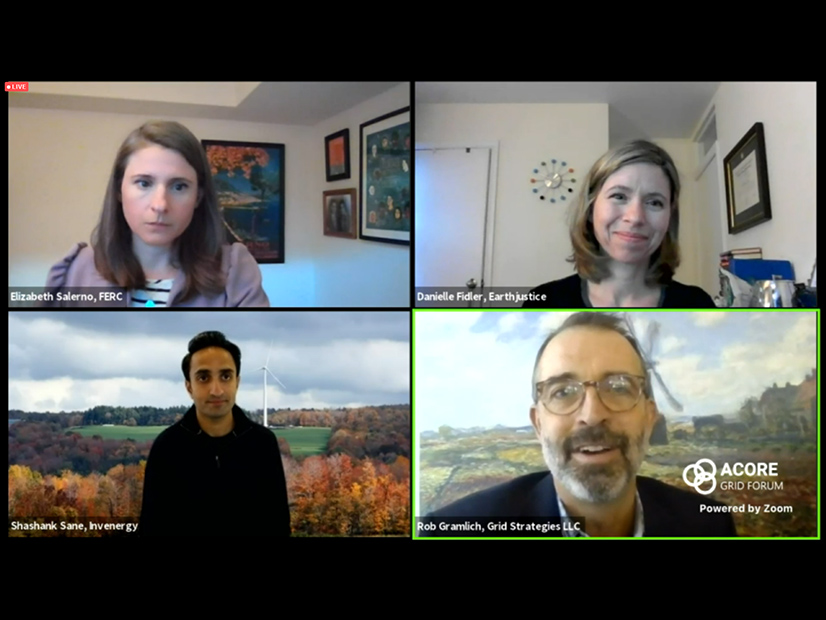The American Council on Renewable Energy held its annual Grid Forum over two days last week. As was the case last year, it was a completely virtual event because of the ongoing COVID-19 pandemic.
The first day of the event, Wednesday, focused on infrastructure policy, transmission planning and energy markets, while Thursday featured discussions on the Biden administration’s agenda.
RTO Insider had coverage of much of the first day last week. (See related stories, Castor: House Democrats ‘100% United’ on Clean Energy Transition and DERs and Clean, Firm Power Needed to Decarbonize Grid.) Here’s more of what we heard.
Christie: Tech Outpacing Regulatory Structures
FERC Commissioner Mark Christie on Wednesday compared the transition to clean resources in the electricity industry to the transition to mobile devices in telecommunications.
The former chair of the Virginia State Corporation Commission, Christie also taught regulatory law at the University of Virginia School of Law. Every year he would ask his students how many of them had a land-line telephone, and every year fewer of them would raise their hands, until the last couple of years, during which not one hand would go up.
But the very last year he taught, one student did raise their hand.
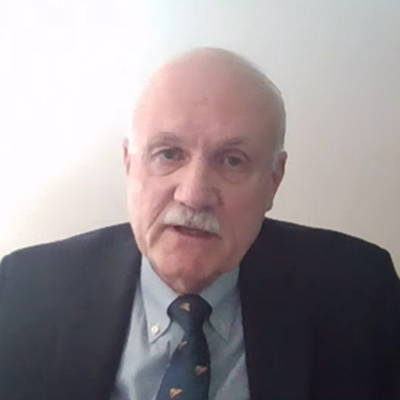 FERC Commissioner Mark Christie | ACORE
FERC Commissioner Mark Christie | ACORE“‘So you have a land line?’” Christie said he asked. “And the student said, ‘Well, what is a land line?’”
Regulating the telephone industry is very similar to regulating electric utilities, going by Christie’s description: Smaller companies would file complaints against the incumbent utilities because they were not interconnecting their services. Meanwhile, the utilities need to file rate cases with the state commission for approval.
By the end of his career at the SCC, however, the commission had not reviewed a telephone utility’s rate case in years. “The law hadn’t changed; the technology had changed,” he said. “Wireless technology eliminated” the natural, networked monopolies held by telephone utilities. “And it didn’t happen because of smart regulators. It happened because smart engineers in a lab figured out how to transmit [voice data] wirelessly on a mass scale at a cost that consumers could afford.”
Distributed energy resources — particularly battery storage combined with rooftop solar — could do the same thing in the electricity space. Disputes over net metering rates would “all go away,” Christie said.
“These are the kinds of technologies [that] I’m really optimistic will be transformative. And the challenge is to make sure the regulatory structures are either not behind or not ahead but try to get a rational connection to this transformational technology that I know we’re going to see.”
ANOPR
Rob Gramlich, president of Grid Strategies, moderated a panel on FERC’s Advance Notice of Proposed Rulemaking on transmission planning.
The panelists reiterated a consensus among many commenters in the ANOPR docket that transmission planning in the U.S. is reactive to generator interconnection requests, the queues for which are backlogged because transmission construction is not keeping up. The ANOPR presents an opportunity for FERC to create a forward-looking approach, they said. (See Transmission Industry Hoping for Landmark Order(s) out of FERC ANOPR.)
“We’re not really planning for the future now, which sort of raises [the question of] why do we even call it transmission ‘planning’ if it’s not about the future generation,” Gramlich said.
He asked Danielle Fidler, senior attorney with Earthjustice, how she would respond if the D.C. Circuit Court of Appeals questions FERC’s authority “to require these plans and allocate these costs so broadly” under a potential final rule. “Where does that come from?”
“Congress in 1935,” Fidler responded laughing. “The Federal Power Act gives FERC really broad authority … and not just authority but obligation to regulate the transmission system. … So in our view, FERC not only should act; it must act.”
An attendee asked about the timeline of the proceeding, specifically whether the commission would wait for the findings of a joint task force with the National Association of Regulatory Utility Commissioners.
Elizabeth Salerno, FERC’s lead for transmission and technology initiatives, could not say when the commission would act, but she did say that “there’s a sense of urgency to start chipping away at the block. The scope of the ANOPR is huge. I think it’s possible we can’t solve all this in one go. There is a consideration of [if we] try to break these up into pieces and tackle them in a logical order. I’m not sure that’s how we’ll go, but I think that option is on the table.”
Gramlich concluded the panel by speaking to the high expectations of the transmission industry for the proceeding. “I spent a couple years of my life on another major rulemaking that never got finalized, so the last thing I want is for all this work to go in” and nothing to come out of it, he said.
Western RTO, SEEM Face Headwinds
A panel Wednesday devoted to the expansion of wholesale markets in the West and the Southeast shared their thoughts on the possibility of future RTOs but had few answers.
Consultant Rebecca Wagner, a former member of the Nevada Public Utilities Commission, noted the alphabet soup of Western markets and organizations, including CAISO’s EIM and proposed EDAM, SPP’s WEIS market and RTO West, the Northwest Power Pool’s WRAP and the Western Markets Exploratory Group (WMEG). (See Western Utilities to Explore Market Options.)
“There’s always something going on in the West,” she said. “There’s a lot of places to plug in to.”
 Rebecca Wagner, Wagner Consultants | ACORE
Rebecca Wagner, Wagner Consultants | ACOREWagner said she hopes that, given Western states’ climate and clean-energy policies, a clean, reliable and affordable grid of the future can be built that unlocks resource diversity and maximizes customer benefits.
“There’s a lot of movement. I’m not sure how it’s going to shake out,” she said.
Colorado Public Utilities Commission Chair Eric Blank said an incremental approach makes the most sense for his state in the near term. The legislature has directed the state’s utilities to join an RTO by 2030 — similar to Nevada legislation — and a regulatory study found that participation in a regional market could yield a 5% cost reduction off $6 billion in revenues, or about $300 million a year, he said.
“There are significant unresolved concerns with RTOs: struggles to ration rare interconnects for resources; fights over cost allocation limiting new transmission; challenging governance structures,” Blank said, pointing to SPP’s four-year backlog in its generator interconnection queue. “For us, we need to see either CAISO’s governance improve or SPP solve its interconnection and cost allocation problems.”
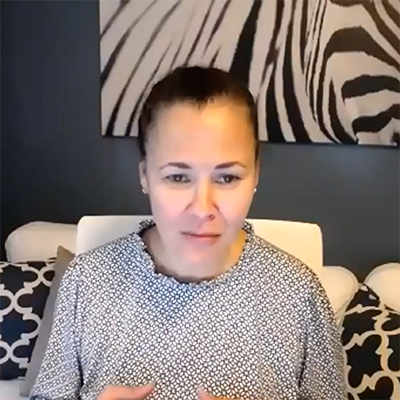 Colorado PUC Chair Eric Blank | ACORE
Colorado PUC Chair Eric Blank | ACOREThe Southern Alliance for Clean Energy’s Maggie Shober said her organization has issues with the proposed Southeast Energy Exchange Market agreement, which went into effect after FERC deadlocked over its approval. (See SEEM to Move Ahead, Minus FERC Approval.)
She said SEEM is “closer to a bilateral market than anything else,” lacks transparency and is not open to independent power producers.
“It’s being pitched as a software upgrade, rather than physically calling people on the phone,” she said. “It’s not a stepping-stone to competition like we’re seeing in Nevada and Colorado.”
In a report on market design and the Southeast, ACORE said, “Absent many traditional market benefits, SEEM is not necessarily a step toward a wholesale power market, but its introduction provides a helpful lens through which to assess energy market design and the Southeast.”
Biden’s Agenda
On Thursday, Kelly Speakes-Backman, principal deputy assistant secretary for the U.S. Department of Energy’s Office of Energy Efficiency and Renewable Energy (EERE) spoke with ACORE CEO Gregory Wetstone about the Biden administration’s clean energy goals.
 Kelly Speakes-Backman, DOE | ACORE
Kelly Speakes-Backman, DOE | ACORESpeakes-Backman, previously CEO of the Energy Storage Association, oversees her office’s $2.8 billion portfolio of research and development, demonstration and deployment activities in energy efficiency, renewable energy, and sustainable transportation.
“We’re focused on supporting President Biden’s clean energy goals of … achieving a carbon-free electric sector by 2035 and [a] clean-energy economy with net-zero emissions no later than 2050. …
“President Biden placed this particular goal at the center of his agenda, and we know that we are kind of the tip of the spear, if you will, for that. So in order to really sort of support that, in driving research and development, but even more so the demonstration and the deployment of these technologies, we’re really underscoring the fact that this is going to create jobs and economic opportunity. Yes, the climate crisis is an enormous challenge. … But we also see this as a huge opportunity to create millions of good-paying, middle-class jobs, to ensure that there’s clean, affordable, reliable energy options for all Americans.”
Environmental Justice
Thursday’s first panel, “Centering Environmental Justice in the 21st Century Grid,” dealt with the impact of grid investments on low- and moderate-income communities.
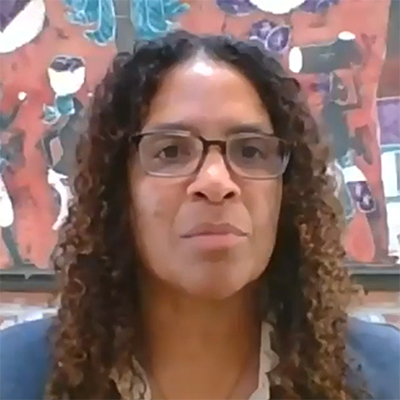 Yvonne McIntyre, NRDC | ACORE
Yvonne McIntyre, NRDC | ACOREYvonne McIntyre, director of federal electricity and utility policy for the Natural Resource Defense Council, moderated a panel that included Jahi Wise, senior adviser for climate policy and finance in the White House Office of Domestic Climate Policy.
McIntyre asked Wise about Biden’s executive orders to implement his Justice40 Initiative, intended to ensure federal agencies work with state and local governments to “make good on President Biden’s promise to deliver at least 40% of the overall benefits from federal investments in climate and clean energy to disadvantaged communities,” according to the White House.
“It’s historic in its scope and scale and trying to orient the federal government around equitable investment in climate and clean energy infrastructure,” Wise said. “Folks who are in this space for a while know that’s not the way that things have historically gone, so the intentionality there is unprecedented.”
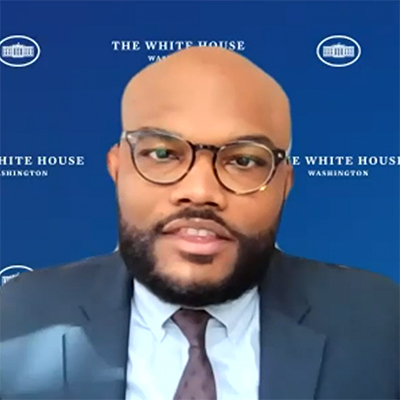 Jahi Wise, The White House | ACORE
Jahi Wise, The White House | ACOREAbout 20 federal government programs are covered by the initiative, he said, “and right now those programs are working through their stakeholder engagement plan, their initial implementation and kind of paving the way for the rest of the federal government to begin this investment process. And so we expect in the next few months to see even more programs join that cohort but also more from the initial set of programs.”
He said that Biden “directed a number of White House components and agencies to put out environmental justice scorecards, and so those scorecards are supposed to be like our first accounting of whether or not we’re actually meeting our targets on environmental justice as a component of climate policy. And that will look at everything from Justice40 to the different environmental justice offices at the agencies. So there’s kind of a really robust, whole-of-government effort on this topic.”
